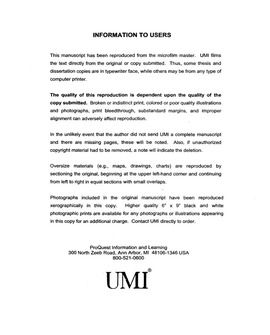| dc.contributor.advisor | Schlegel, Robert E., | en_US |
| dc.contributor.author | Hwang, Byeong-cheol. | en_US |
| dc.date.accessioned | 2013-08-16T12:18:16Z | |
| dc.date.available | 2013-08-16T12:18:16Z | |
| dc.date.issued | 2001 | en_US |
| dc.identifier.uri | https://hdl.handle.net/11244/325 | |
| dc.description.abstract | Fitts' Law was a valid model of performance for assessing the levels of impairment for both groups. Movement time (MT) and Fitts' Law index of performance (IP) correlated strongly with the MMDT scores and served as valid metrics for assessing the use of computer input devices by people with upper-limb motor impairments. This research developed and validated a sound approach to input device selection and functional limitation assessment to improve the match between computer pointing task requirements and the capabilities of challenged users. | en_US |
| dc.description.abstract | Many computer users with motor impairments frequently use standard input devices even though these devices are not best suited for them. A methodology for specifying alternative assistive input devices as a function of type and degree of functional limitation is important for improving access to computer technology. The current research developed a matrix for matching assistive technology input devices to the assessed level of functional limitation. Since there are few reliable input device assessment instruments for people with impairments, this research also developed and validated a methodology for assessing the level of impairment for people with upper-limb motor impairments. | en_US |
| dc.description.abstract | Computer pointing task performance for 23 unimpaired participants (mean = 28.2 years, SD = 5.7 years) and 11 participants with upper extremity impairments (mean = 25.8 years, SD = 10.0 years) was evaluated using three input devices (joystick, trackball, and mouse) and a Fitts' Law test. Impairments represented in this study included cerebral palsy, spina bifida, head injury, muscular dystrophy, spinal cord injuries, and multiple disabilities. The Minnesota Manual Dexterity Test (MMDT) was used to assess manual dexterity. Each Fitts' Law target was square in shape with a width of 5, 15, or 25 mm. Movement amplitude from the start point to the center of the target was 40, 80, or 160 mm. Movement directions for the unimpaired group were 0 (East), 90 (North), and 225 (Southwest) degrees, but were limited to 0 and 90 degrees for participants with impairments. The control-display (CD) gains used in this study were 0.5 and 1.0. There was one practice session and two main sessions. In each run, each combination of target size, movement amplitude and movement direction appeared four times in random order. A separate run was conducted for each device and CD gain combination. Each unimpaired participant pointed to 108 targets per run and participants with impairments pointed to 72 targets per run. | en_US |
| dc.format.extent | xi, 240 leaves : | en_US |
| dc.subject | Computer input-output equipment. | en_US |
| dc.subject | Motor ability. | en_US |
| dc.subject | Computer users. | en_US |
| dc.subject | Health Sciences, Occupational Health and Safety. | en_US |
| dc.subject | Engineering, Industrial. | en_US |
| dc.subject | People with disabilities. | en_US |
| dc.title | Methodology for the selection and evaluation of computer input devices for people with functional limitations. | en_US |
| dc.type | Thesis | en_US |
| dc.thesis.degree | Ph.D. | en_US |
| dc.thesis.degreeDiscipline | School of Industrial and Systems Engineering | en_US |
| dc.note | Source: Dissertation Abstracts International, Volume: 62-04, Section: B, page: 2005. | en_US |
| dc.note | Adviser: Robert E. Schlegel. | en_US |
| ou.identifier | (UMI)AAI3013149 | en_US |
| ou.group | College of Engineering::School of Industrial and Systems Engineering | |
